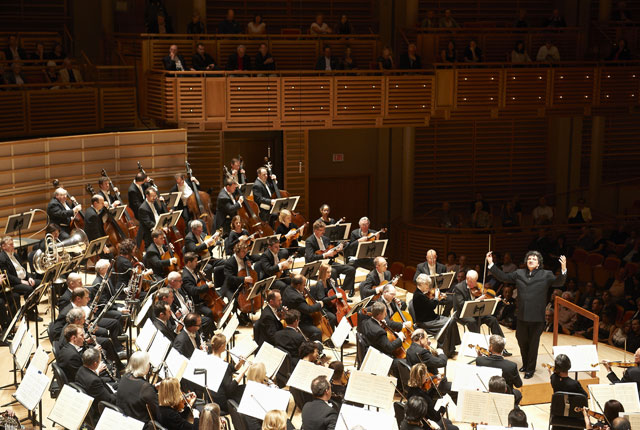One of the premier orchestras in the world looks to cement its place in Miami
 Miami plays host to some of the finest arts organizations and events in the nation. For several seasons now, South Florida also has been the locale for what is arguably the greatest symphony in the United States, the Cleveland Orchestra.
Miami plays host to some of the finest arts organizations and events in the nation. For several seasons now, South Florida also has been the locale for what is arguably the greatest symphony in the United States, the Cleveland Orchestra.
Not only does the Cleveland Orchestra have the highest national standing, but over its ninety-four years, it has secured a reputation as quite possibly the finest orchestra in the world. And now it reaches out in a desire to bring its performances to even more patrons. The Orchestra has established special relationships with music programs in New York City, Lucerne and Vienna and a residency at the University of Indiana and it travels to these areas routinely.
For the past five seasons, the Orchestra also has come here for three weeks every winter and has taken residence at the Adrienne Arsht Center for the Performing Arts in downtown Miami. This South Florida-oriented program, the Miami Residency, has the orchestra not just performing full-length classical pieces but also engaged in so much more. Bruce Coppock, the managing director of The Cleveland Orchestra Miami, places emphasis on a good amount of community involvement.
“The Cleveland Orchestra of Miami has a mission: to serve Miami in a pretty broad way with a combination of orchestra concerts, education concerts, educational activities with the schools [and] partnership activities with other Miami-based cultural organizations. So it’s actually a one-of-a-kind venture in the country.”
The Musical Arts Association of Miami, the board that governs the Residency, was created around six or seven years ago when local cultural and business leaders, twenty-five in number, sat down together to determine if South Florida could get access to the world’s great orchestras. This was more than simply an intellectual exercise: There was real need behind the question.
South Florida’s classical offerings were disappearing. The old Miami Philharmonic Orchestra was long gone, having closed up shop in the 1980s. More recently, the Florida Philharmonic Orchestra had shut down due to money woes in Spring 2003. Even the one local classical radio station, WTMI 93.1 FM, had been purchased and its playlist retired in 2002. (Classical South Florida at 89.7 FM, a nonprofit public radio organization, began broadcasting in October 2007.)
These losses didn’t sit well with a notable segment of South Florida’s residents and visitors. While Miami might be considered second-tier in some regards, there still remains a well-established cadre of patrons here who are dedicated to the fine arts. This love has been noted especially in the Cuban and South American communities and in those who come down from the Northeast with its older, more established cities.
Says Coppock, “I can’t tell you statistics [offhand], but I can tell you my impressions: There are far more Hispanics than I’ve ever seen in any symphony I’ve been in. I’m familiar with almost every single orchestra market in the country, and the audiences for the Cleveland Orchestra concerts in Miami – I went to the first one in January of last year – are far more diverse than any audiences I’ve ever seen in any other concert hall anywhere in the country… I’ve had extraordinary conversations with members of the Cuban community – a couple are on the board – about their deep commitment, how this music is very much a part of their family tradition.”
Coppock defines the Residency’s mission as three-fold, the first of which is to increase the number of concerts. Can the Orchestra accomplish what it wants to in the time frame it currently maintains? Having only three weeks may be constraining its effectiveness, even with partners to pick up the slack. Offering more performances could be accomplished via a longer season, so this option is under discussion.
“So whether it’s three and one-half weeks, or four weeks, or five weeks, that’s yet to be determined…This is something we’re thinking about very deeply. The board is in the middle of a very thoughtful process, evaluating the next steps for a musical life in Miami.”
A second facet is offering more educational opportunities that are open to the community at large, what Coppock calls “a wider, broader footprint in the community that takes place over the concert season, over the school year, on a more-regular basis.” Music education, he says, is a huge subject that can encompass possibly more concerts, or more teaching opportunities, or more projects with local music organizations. Or possibly all three in some combination. He mentions the University of Miami Frost School of Music, the New World Symphony and Miami City Ballet as well-established partnerships that remain in play.
The third facet is a stronger working relationship with local arts institutions. “Deeper, more-sustained partnerships of all stripes and colors with other Miami institutions. We want to be a genuine part of the Miami community. We don’t want to just fly in and play concerts.” Presently, the Residency’s outreach programs serve over 20,000 teens and adults. In addition, the Orchestra gives free education concerts to more than 3,500 elementary school students. And these numbers don’t take into consideration free master classes for university-level students.
There are any number of options to consider for the future, of what realistically can be accomplished, especially in light of the general economy. The original group of donors numbered twenty-five; there are now 500 – a twenty-fold increase. Audience numbers have stayed almost the same from the beginning, with only a slight downturn during the worst of the recession. At this point, however, the concerts have a ninety-two percent sell-out rate, which invokes the major area of activity for the Residency: paying performances.
On January 27-28, the Cleveland Orchestra’s Music Director, Franz Welser-Möst, lead the Orchestra in Sean Shepherd’s Wanderlust, Shostakovich’s Symphony No. 6 in B-minor and Brahms’ Piano Concerto No. 2 in B-flat with Yefim Bronfman as soloist.
On March 2-3, the Orchestra will perform Verdi’s Triumphal March and Ballet Music from Aïda, the Miami premiere of Osvaldo Golijov’s Three Songs for Soprano and Orchestra with Dawn Upshaw as soloist, and Prokofiev’s Symphony No. 5. Nicola Luisotti will make his Cleveland Orchestra and Miami debuts as conductor.
The Orchestra will present two education concerts entitled ¡Música Fantástica! on March 22 with triple Grammy-nominated Miami band Tiempo Libre. This unique program examines the origins of symphonic tradition, from its beginnings in Africa, through its mutations in Europe and then onto influences from Latin America and the Caribbean basin.
On the 23rd, the Orchestra, conducted by Giancarlo Guerrero, will perform Beethoven’s Symphony No. 6 (“Pastoral”), Respighi’s The Pines of Rome, and Grieg’s Piano Concerto in A-minor with Gabriela Montero as soloist in what will be her Miami Residency debut.
This season will be Guerrero’s first as the Residency’s Principal Guest Conductor, a newly created position responsible for programming and conducting subscription performances and special events, planning community outreach projects and guiding the artistic vision of the Residency.
¡Música Fantástica!, with the same selections and musicians, will be performed again as a Family Concert on March 24. It will be conducted by Giancarlo Guerrero.
Guerrero lead separate master classes for both conducting students and the Music Wind Ensemble at the UM Frost School of Music on January 25. On March 20, he is scheduled to conduct a rehearsal with FIU music
students, which will be open and free to the public.
It comes down to choices, says Coppock, who puts the challenge succinctly. Can Miami be really smart about “using the extraordinary assets” that are already in place down here? He mentions the Arsht Center, the Knight Concert Hall, the New World Symphony and how South Florida has a “distinct and unique set” of musical cultural assets. There is the Frost School of Music, he says, and the acting program at FIU, and all the help available at Michael Spring’s office, the Department of Cultural Affairs for Miami-Dade County.
“I really, truly believe within twenty-five years Miami will be perhaps second only to New York as a cultural center in America,” he says. “Look at what’s happened with Art Basal! In ten short years, Miami is a significant stop in the visual-arts world. It’s got a one-of-a-kind relationship with the world’s greatest orchestras. It’s got a fantastic concert hall. And it’s got a rich, diverse, culturally aware citizenship. Those are the ingredients of a very rich future.”
The Cleveland Orchestra Miami
www.clevelandorchestramiami.com



Be the first to comment